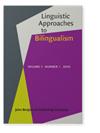法语三级和德语三级的动词位置
IF 1.8
2区 文学
0 LANGUAGE & LINGUISTICS
引用次数: 1
摘要
摘要本文探讨了母语挪威语二语德语和法语三语学习者三语动词位置习得过程中的跨语言影响以及表层结构和底层句法结构之间的关系。在这些语言中,动词的位置有系统地变化。先前的研究发现,在相似的语言组合中,母语和第二语言都有迁移。使用可接受性判断任务,我们测试了动词在非主语首句和主语首句中的位置。研究结果表明,三级法语学习者在非主语首句上的表现优于三级德语学习者,而三级德语学习者在非主语首句上的表现则相反。我们认为,我们的发现可以用动词运动的生成解释来解释,并且与一种分析相一致,即动词在L3学习者的潜在句法表征中没有移动,或者移动得不够远。假设动词移动是一种代价高昂的操作,我们认为三语习得中的句法操作动词移动受到经济原则的约束,而经济在多语习得中起着决定跨语言影响的作用。我们的研究与对第一、二、三语动词运动习得的统一分析是一致的,并强调了不同习得过程中的质的相似性。本文章由计算机程序翻译,如有差异,请以英文原文为准。
Verb placement in L3 French and L3 German
Abstract This article explores cross-linguistic influence and the relationship between surface structure and underlying syntactic structure in L3 acquisition of verb placement in L1 Norwegian L2 English learners of L3 German or French, respectively. In these languages, verb placement varies systematically. Previous research has found transfer from both L1 and L2 in similar language combinations. Using an acceptability judgment task, we tested verb placement in non-subject-initial and subject-initial sentences. Findings indicate that L3 French learners performed better on non-subject-initial sentences compared to subject-initial sentences, whereas the opposite was the case in L3 German. We argue that our findings can be explained by a generative account of verb movement and are compatible with an analysis where verbs do not move, or do not move far enough, in the L3 learners’ underlying syntactic representation. Following the assumption that verb movement is a costly operation, we argue that the syntactic operation verb movement is constrained by principles of economy in L3 acquisition, and that economy plays a role in determining cross-linguistic influence in multilingual acquisition. Our account is compatible with a uniform analysis of the acquisition of verb movement in L1, L2 and L3, and underlines the qualitative similarities in different acquisition processes.
求助全文
通过发布文献求助,成功后即可免费获取论文全文。
去求助
来源期刊

Linguistic Approaches To Bilingualism
Social Sciences-Linguistics and Language
CiteScore
3.20
自引率
9.10%
发文量
24
期刊介绍:
LAB provides an outlet for cutting-edge, contemporary studies on bilingualism. LAB assumes a broad definition of bilingualism, including: adult L2 acquisition, simultaneous child bilingualism, child L2 acquisition, adult heritage speaker competence, L1 attrition in L2/Ln environments, and adult L3/Ln acquisition. LAB solicits high quality articles of original research assuming any cognitive science approach to understanding the mental representation of bilingual language competence and performance, including cognitive linguistics, emergentism/connectionism, generative theories, psycholinguistic and processing accounts, and covering typical and atypical populations.
 求助内容:
求助内容: 应助结果提醒方式:
应助结果提醒方式:


